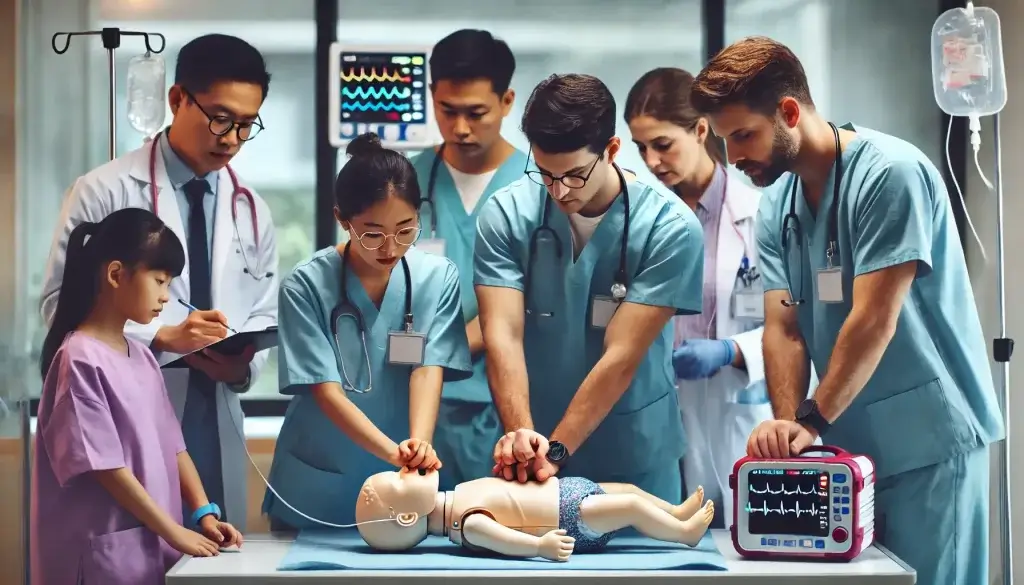Cardiopulmonary resuscitation (CPR) is a life-saving skill that’s important when a child is facing a medical crisis that needs to be checked immediately. Unlike adults, children have unique physiological needs that require specialized techniques. Here the role of courses on CPR for healthcare providers comes to mind. They can make a great difference in pediatric emergencies. In this blog, we’ll explore how CPR training helps healthcare providers handle pediatric emergencies with precision, teamwork, and confidence.

Role of CPR in Pediatric Emergencies: Facts and Statistics
Every year, over 15,200 children in the U.S. experience cardiac arrest during hospital stays, often in intensive care units or other highly monitored settings. These incidents are mainly triggered by severe breathing problems or shock. While 80% to 90% of these children initially survive after receiving CPR, the majority sadly do not recover enough to leave the hospital.
In about half of these CPR cases, the heart’s rhythm becomes dangerously slow, struggling to pump blood effectively. Only about 10% of the time, this rhythm can return to normal with the use of a defibrillator. To avoid these emergencies, hospitals prioritize identifying children at risk and keeping them in closely monitored environments.
CPR for children involves a combination of techniques: delivering firm and effective chest compressions, using a defibrillator when necessary, managing breathing and airways, and administering epinephrine to improve blood flow to the heart. The CPR also addresses the underlying cause of the arrest. New advancements, like advanced newborn CPR techniques, including specialized machines to maintain circulation to better support recovery, are being explored.
Once a child’s heart starts beating again, the focus shifts to post-cardiac arrest care. This involves carefully controlling body temperature, stabilizing blood flow and pressure, and providing comprehensive support in the ICU. These efforts boost survival rates and help minimize the risk of brain damage, offering a better chance for a full recovery.
The Unique Challenges of Pediatric Emergencies
Children aren’t just smaller versions of adults. Their bodies work differently, and they have unique medical needs, especially in emergencies. For example, their airways are smaller and can get blocked more easily, and their hearts react differently to stress. That’s why specialized training in pediatric care is so important.
In CPR for healthcare providers, the providers need to quickly spot signs of trouble in kids. Issues like breathing problems, shock, or cardiac arrest demand immediate action to give children the best chance of recovery.
How CPR Training Prepares Teams
Sudden cardiac arrest in children is rare but can occur due to various reasons, such as respiratory failure, trauma, or congenital heart conditions. Unlike adults, where cardiac arrest often stems from heart disease, pediatric cardiac arrest is frequently secondary to breathing issues or asphyxia. This makes immediate and effective CPR even more required.
Pediatric emergencies demand seamless teamwork. CPR for healthcare providers incorporates team-based training, fostering collaboration and communication under pressure. Here’s how CPR for healthcare providers enhances team preparedness:
Clarity in Roles
In an emergency, having clear roles ensures everything runs smoothly, especially in high-pressure situations like pediatric CPR. During CPR for healthcare providers, the healthcare teams practice in realistic simulations, where each member takes on specific roles like team leader, airway manager, or chest compressor. This hands-on training helps team members understand their responsibilities and work seamlessly together during real crises.
The team leader oversees the process, making sure of clear communication and coordination, while the airway manager focuses on keeping the child’s breathing stable, and chest compressors perform life-saving compressions. These well-defined roles reduce chaos, save time, and improve outcomes in pediatric emergencies.
Psychological Preparedness
Pediatric emergencies are emotionally intense, not just for the child and their family but also for the healthcare providers managing the crisis. CPR for healthcare providers goes beyond teaching techniques. It helps in building the mental resilience needed to handle these high-pressure situations.
Healthcare providers gain confidence in their ability to act quickly and decisively by practicing real-life situations. This preparedness of healthcare providers reduces panic and helps them stay composed during CPR. Staying calm is not just about performing better; it also reassures the team and the child’s family to build up trust. A clear mind and steady hands can make all the difference in saving a child’s life.
The Impact of Timely Intervention
Research indicates that immediate CPR can double or even triple a child’s chances of survival following cardiac arrest. In pediatric cases, every second counts. For example, if a child stops breathing or their heart ceases to function, initiating CPR within minutes can stabilize their condition until advanced medical help arrives.
Moreover, choking incidents are among the leading causes of preventable deaths in children. Training in CPR for healthcare providers provides them with the knowledge of how to perform the Heimlich maneuver effectively, potentially saving lives during choking emergencies.
Real-Life Applications of CPR Training
In practice, CPR for healthcare providers for pediatric emergencies has many applications in various settings. These settings are-
Schools and Daycare Centers
Teachers and staff trained in pediatric first aid and CPR can respond swiftly to accidents or health crises involving children. Their ability to provide immediate care often stabilizes situations until emergency services arrive.
Emergency Rooms
In hospital settings, nurses and doctors utilize their CPR training daily. They are often the first responders when a child experiences a medical emergency, making their training important for the children.
Community Confidence
When parents know healthcare teams are well-trained in pediatric CPR, it builds trust and reassurance. Seeing confident, skilled professionals ready to act in emergencies helps families feel their child is in safe and capable hands.
The Lifesaving Value of CPR Training
Pediatric emergencies are among the most challenging situations healthcare providers face. Mastering CPR for healthcare providers provides teams with the skills, knowledge, and confidence to navigate these critical moments effectively. Through technical expertise, healthcare professionals can provide the highest standard of care during pediatric emergencies. In the end, the ability to save a child’s life is one of the most rewarding aspects of healthcare, and it all starts with being prepared.

